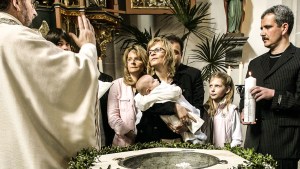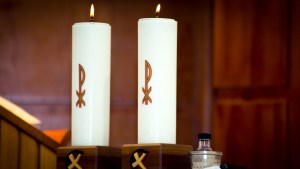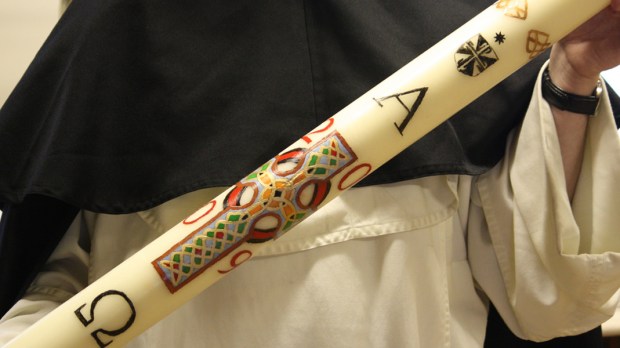Not surprisingly, early Christians used candles in their liturgies. Initially this was done for practical purposes (especially when praying in the catacombs), but the light coming from the candles quickly became symbolic.
The candle-lit ceremonies reminded Christians of Jesus’ words in the Gospel of John, “I am the light of the world; he who follows me will not walk in darkness, but will have the light of life” (John 8:12). For this reason candles became a central part of Christian worship and were associated with the light of Christ.
Besides using multiples candles for practical illumination purposes, there began a tradition where a single candle was used as a direct symbol of Jesus. According to Fr. Edward McNamara, “The most likely origin [of the Easter candle] is that it derived from the Lucernarium, the evening office with which early Christians began the vigil for every Sunday and especially that of Easter. In turn, this rite is probably inspired by the Jewish custom of lighting a lamp at the conclusion of the Sabbath. The rite therefore has its roots in the very beginning of Christianity. In the Lucernarium rite the light destined to dispel the darkness of night was offered to Christ as the splendor of the Father and indefectible light. This Sunday rite was logically carried out with greater solemnity during the Easter Vigil.”
Over time the Easter candle was given greater prominence and was decorated to further expound on the Paschal mystery. Below is a brief guide to the Easter candle along with the corresponding symbolism.
Wax Candle
According to the Catholic Encyclopedia, “The pure wax extracted by bees from flowers symbolizes the pure flesh of Christ received from His Virgin Mother, the wick signifies the soul of Christ, and the flame represents His divinity.”
Light
The Roman Missal summarizes this symbolism perfectly, “May the light of Christ rising in glory dispel the darkness of our hearts and minds.” This connects the Easter candle to Jesus, “light of the world,” as he describes himself in the Gospel of John.
From the Easter candle are lit all the other candles in the church, showing how Jesus is the source of our light.
Flame
The flame is reminiscent of the “pillar of fire” that led the people of Israel and protected them as they escaped the slavery of the Egyptians. The Exsultet refers to this symbolism when it states, “This is the night that with a pillar of fire banished the darkness of sin.”
Cross
The cross is the supreme symbol of Jesus and the instrument through which he saved the world from sin and death.
Alpha and Omega
It is common in Christian art to find two Greek letters: the alpha (Α) and omega (Ω). These two letters have an ancient history in Christianity and are rooted in the book of Revelation, where Jesus says, “I am the Alpha and the Omega, the beginning and the end. To the thirsty I will give water without price from the fountain of the water of life. He who conquers shall have this heritage, and I will be his God and he shall be my son” (Revelation 21:6-7).
Year
As the priest traces the year on the Easter candle, he prays, “All time belongs to him, and all the ages.” This reminds us that God is here with us today and is constantly guiding all creation to himself.
Grains of incense
Five grains of incense are inserted into the candle on top of the cross, symbolizing the five “holy and glorious wounds” of Jesus Christ.

Read more:
Why you might see that Easter candle again this year

Read more:
Why do Catholics use candles at Mass?

